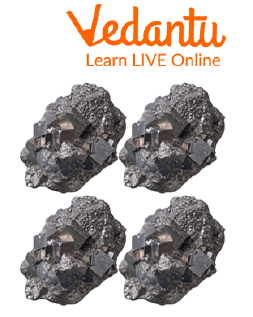




Introduction to Iron
The periodic table's group VIII element, iron, is a metal. It is a silver-grey colour and is glossy, ductile, and malleable. It ranks as the eighth most prevalent element in the cosmos. It is present in significant quantities in the molten form at the Earth's core.
For example, a nail can be made out of iron (Fe). Iron remains an element even after being sliced in half. You will still be holding the essence of iron if you keep cutting the nail until it is so tiny that you can hardly see it. Let’s now see more about it in detail.

Iron
Iron Metal Properties
Some properties of iron are as follows:
Iron has numerous characteristics that make it extremely beneficial in a variety of industries, from metallurgy to recycling. Although it is by no means exhaustive, the list below does give some information about some of the iron's characteristics:
Ferromagnetic Ability - this means that iron can form magnets or be attracted to magnets, which means it’s easier to separate it from non-ferrous materials.
Hardness - The degree of hardness of iron is one of its most well-known mechanical characteristics. Iron is a hard metal that may be utilized in a wide range of applications and industries. When mixed with other materials, iron becomes a very powerful metal.
Low Cost - Iron metal is also inexpensive, which makes it valuable for many global industries.
Malleability - Iron is malleable and may deform under pressure, such as when being hammered.
Dissolvable - Iron dissolves in dilute acids.
Conductivity - This element is a good conductor of heat and electricity and is also easily magnetic.
Uses of Iron
Some uses of iron are as follows:
It is used in the production of steel as well as the construction of girders and other reinforced concrete structures.

Bed Made from Iron
Steel, which is frequently utilised in industrial and civil engineering today, is created from iron. Stainless steel, which has strong corrosion resistance, is frequently used in cookware, appliances, and other kitchenware. It is also used in medical equipment.
Alloy steels, which are carbon steels with additions like nickel, chromium, vanadium, tungsten, and manganese, are made from iron.
Iron is used in a variety of everyday objects, such as tools, machinery, automobiles, ship hulls, building structural components, bridges, and aircraft.
These are utilized to create rifle barrels, bicycle chains, bicycle towers, and bridges.
Cast iron has a 3-5% carbon content. It's used in pumps, valves, and pipes.
In the Haber process, which creates ammonia, iron catalysts are used.
This metal, as well as its alloys and compounds, can be used to make magnets.
Iron Alloys
Due to its widespread availability, iron is a very significant and necessary element in our daily life. It is also an essential part of many alloys. The following are a few of the most popular iron alloys and the uses of iron alloys are as follows:
Steel- A material made of iron and carbon, is widely used in building, making weapons, and transportation.
Stainless Steel- It has extraordinarily high corrosion resistance and is produced by adding at least 10.5% chromium, is the ideal material for demanding conditions. This alloy is malleable, has low tensile strength, and is neither very brittle nor ductile.
Cast Iron - Made from pig iron and alloyed with silicon and carbon (3%-5%), cast iron is strong, light, and well-suited for use in a variety of applications.
Iron and Nickel - This combination makes an alloy that is more heat- and acid-resistant.
Iron and Manganese- This alloy is incredibly durable.
Iron and Tungsten - An alloy that can sustain hardness at high temperatures are created by mixing tungsten with iron.
Interesting Facts About Iron
Enjoy this collection of fascinating iron and steel facts. Discover the functions, qualities, and historical applications of iron and steel.
Iron is a metal and chemical element. Fe is its chemical symbol, and 26 is its atomic number.
On the Earth's surface, iron is rarely found in its pure metal state because it oxidizes so quickly. Instead, it is taken out of the ores (rocks containing important minerals and elements).
Puddle iron was used to construct Paris, France's Eiffel Tower. A type of wrought iron with an extremely low carbon content is called "puddle iron”. While wrought iron was widely used throughout Western history, it is no longer produced in considerable quantities because of the availability of steel.
Iron and steel can be painted, covered in plastic, galvanized (coated with zinc), or protected from rust damage using other techniques that keep out oxygen and water.
A lot of diverse items may be made out of iron, which are quite inexpensive to create.
Iron is frequently used in the construction of tools, cars, and buildings (usually in the form of steel).
Summary
This article on interesting facts about iron taught us that one of the transition elements is the metallic chemical element iron. The second most prevalent metal, the most accessible metal, and the fourth most prevalent element in the Earth's crust. Iron is the only metal that can be tempered because it is ferromagnetic at normal temperatures. It is used in a wide variety of steel products, including cast and wrought iron.
A diet high in iron is essential for optimal health since the human body contains about one-sixth of an ounce (4.5 g) of iron, mostly in the form of haemoglobin and its precursors. We hope you enjoyed reading this article.
FAQs on Interesting Facts About Iron
1. What function does the element iron serve?
It is a fundamental component of steel and aids in the blood's oxygenation as well as the hydration of plants.
2. What is the iron atomic number?
Chemically, iron is an element with the atomic number 26 and the symbol Fe. It is a metal that is a member of group 8 and the first transition series of the periodic table. By mass, it makes up the majority of both the outer and inner core of the Earth, making it the most prevalent element.
3. Why is the melting point of iron so high?
To melt or boil a metal, one must overcome the attraction between the metal ions and the displaced electrons. Metals have high melting and boiling temperatures because such solid forces of attraction exist. Thus, iron also has high melting point.
4. What types of iron are there?
These materials include plain iron, wrought iron, cast iron, pig iron, and direct reduced iron, among others. Fresh iron produced in an electric arc furnace, where high enough temperatures may be attained to melt the iron, is referred to as pure iron.









